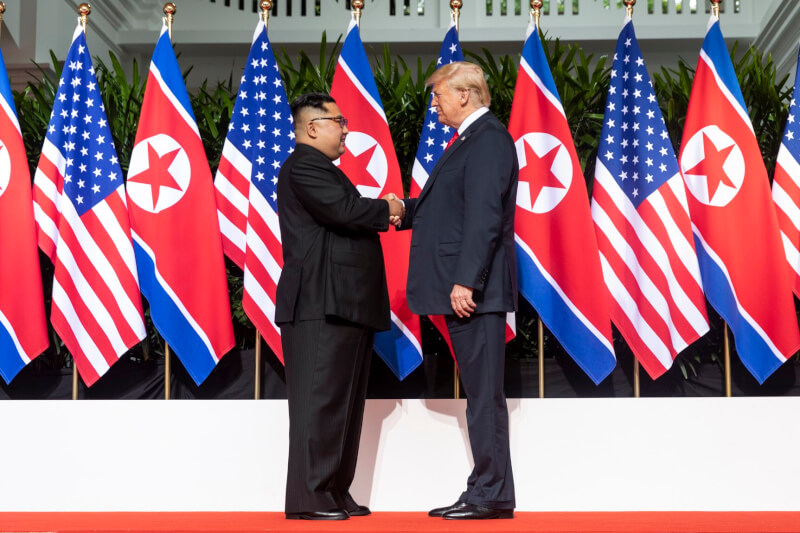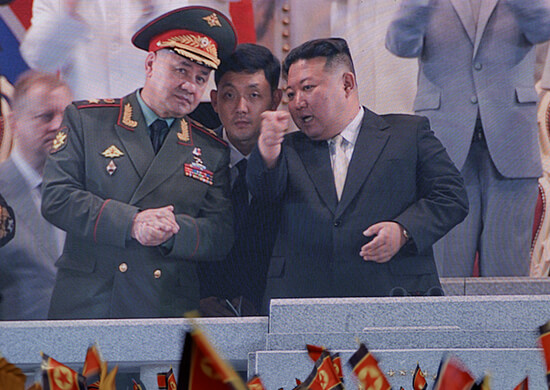
North Korean President Kim Jong-un has broken with long-held policy and declared he no longer believes peaceful reunification with the South is possible.
[Wikimedia]
Addressing North Korea’s rubber-stamp parliament, Kim said he no longer believed peaceful reunification was possible. He accused the South of attempting to foment regime change and promoting reunification by stealth.
“We don’t want war, but we have no intention of avoiding it,” he claimed.
The Koreas have technically been at war since June 25, 1950, when Soviet-backed North Korean forces crossed the 38th parallel into South Korea. The peninsula was occupied by the Japanese during the Second World War and partitioned by its American and Soviet liberators in 1945.
An armistice ended the fighting in 1953 but no peace treaty was ever signed. Tensions have waxed and waned ever since.
But now North Korea’s state-run news agency, KCNA, has reported that Pyongyang is closing the three agencies overseeing unification and tourism between the Koreas: the Committee for the Peaceful Reunification, the National Economic Cooperation Bureau and the Mount Kumgang International Tourism Administration.
“The two most hostile states, which are at war, are now in acute confrontation on the Korean peninsula,” KCNA said after Kim appeared to end decades of official policy aimed at reconciliation and reunification. “The reunification of Korea can never be achieved with the Republic of Korea.”
Kim said a war would “decimate” South Korea and deal an “unimaginable” defeat to its biggest ally, the United States, which the U.S. Congress says has 28,500 troops stationed in the country.
“In the event of war on the Korean peninsula, I think it is also important to reflect on the issue of completely occupying, suppressing, and reclaiming [South Korea] and incorporating it into the territory of our Republic,” Kim said.
South Korean President Yoon Suk Yeol accused Pyongyang of being “anti-national” and condemned a recent missile launch and live-fire exercise near the countries’ tense maritime border. He warned provocations would invite retaliation on a “multiplied scale.”

North Korean soldiers March in Pyongyang in 2013 wearing chemical, biological, radiological and nuclear defence (CBRN) equipment.
[Wikimedia]
“That may sound overly dramatic, but we believe that, like his grandfather in 1950, Kim Jong Un has made a strategic decision to go to war,” experts Robert L. Carlin and Siegfried S. Hecker wrote in the journal examining the North’s affairs.
“We do not know when or how Kim plans to pull the trigger, but the danger is already far beyond the routine warnings in Washington, Seoul and Tokyo about Pyongyang’s ‘provocations,’” they said.
“This bedrock policy shift by Kim to gird for a war would only come after he concluded all other options had been exhausted, and that the previous strategy shaping North Korean policy since 1990 had irrevocably failed.”
They said that policy—to normalize relations with the United States as a buffer against China and Russia—was diminished when, in Pyongyang’s eyes, successive U.S. administrations pulled away from engagement and largely ignored North Korean initiatives.
“During the Barack Obama Administration, the North made several attempts that Washington not only failed to probe but, in one case, rejected out of hand. There is much debate in the United States whether the North was ever serious, and whether dialogue was simply a cover for developing nuclear weapons.
“Our view is that argument was seriously flawed at the time, and today, it stands in the way of understanding not simply why things have developed to such a perilous stage, but more importantly, how dangerous the situation actually is.
“The issue has moved far beyond assigning blame.”
The authors also point to the failure of Kim’s second summit with former U.S. president Donald Trump, held in Hanoi in August 2019, to normalize relations with the Americans. They call it “a traumatic loss of face for Kim.”

Kim and U.S. President Donald Trump shake hands at the outset of the June 2018 North Korea–U.S. summit in Singapore.
[Wikimedia]
In early 2023, the sabre-rattling started appearing regularly in high-level North Korean pronouncements for domestic consumption. Kim even resurrected language calling for “preparations for a revolutionary war for accomplishing…reunification.”
In their analysis, titled Is Kim Jong Un preparing for war?, the authors say Washington and Seoul cling to the belief that their alliance backed by “ironclad” deterrence will keep Kim on the status-quo trajectory.
“There is a belief, entirely understandable, that more and more frequent symbols of our intent to retaliate will keep the North at bay, as will our oft-stated conviction that if the North attacks, the counterattack will totally destroy the North Korean regime. Yet, in the current situation, clinging to those beliefs may be fatal.
“The evidence of the past year opens the real possibility that the situation may have reached the point that we must seriously consider a worst case—that Pyongyang could be planning to move in ways that completely defy our calculations.”

Kim with Russian Defence Minister Sergei Shoigu in Pyongyang in July 2023.
[Wikimedia]
“If, as we suspect, Kim has convinced himself that after decades of trying, there is no way to engage the United States, his recent words and actions point toward the prospects of a military solution using that arsenal,” they said.
“If that comes to pass, even an eventual US-ROK victory in the ensuing war will be empty. The wreckage, boundless and bare, will stretch as far as the eye can see.”

A North Korean ballistic missile on parade in 2013.
[Wikimedia]
Advertisement


















